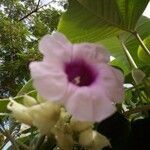Large, glabrous, perennial liana. Roots tuberous. Stems twining, rarely prostrate, hollow, becoming woody. Leaves ovate-cordate to orbicular in outline, 60-200 x 60-150 mm, base cordate or truncate, entire to shallowly lobed or palmately dissected beyond the middle; lobes 3-9, lanceolate to ovate, entire, apex acuminate to obtuse; petiole smooth or muriculate, 30-110 mm long. Peduncles terete to angular, cymosely branched near apex, few-to many-flowered, 25-200 mm long; pedicels 9-25 mm long. Sepals equal or outer ones shorter, all suborbicular or outer ones narrower, obtuse, markedly convex, coriaceous, 6-12 mm long. Corolla funnel-shaped with spreading limb, 50-60 mm long, 60-70 mm wide, tube narrow below and then widening, reddish purple or mauve with darker centre. Capsule globose or ovoid, 12-14 mm long. Seeds black, 5-7 mm long, with ±7 mm long whitish silky hairs.
A strong climbing plant. Its stems twine around objects or creep over the ground. It grows 4.5 m high and spreads 1.8 m wide. They grow from a root tuber. Plants die down each year and re-grow from the tuber. The young growth is bright green and shiny. The leaves can be 25 cm across and divided like fingers on a hand into 5-9 narrow lobes. These can be 15 cm long by 4 cm wide. Leaves are dark green and are thin in texture. The leaflets are drawn out to a point. Flowers occur in groups of 3-9 in the axils of leaves. Flowers are 6-8 cm across and mauve. They have a darker centre in the trumpet shaped flowers. The seed capsule is 1.5 cm across and round and leathery. The seeds are woolly. The tuber is large. It can occur under ground or near the surface.
Large, glabrous liane with tuberous roots; stems twining.. Leaf-blade orbicular in outline, entire or palmately 3–9-lobed, 6–24 cm. long, 6–18 cm. wide, cordate or truncate at the base; lobes lanceolate to ovate, acuminate at the apex, entire; petiole 3–11 cm. long.. Inflorescences few-to many-flowered; peduncles 2.5–20 cm. long; pedicels 0.9–2.5 cm. long; flower-buds globular.. Sepals markedly convex, clasping the corolla-tube, orbicular or elliptic, 6–12 mm. long.. Corolla reddish-purple, funnel-shaped, with the tube narrow below, 5–6 cm. long.. Capsule ovoid, obtuse, 1.2–1.4 cm. long.. Seeds 6–7 mm. long, black, covered with ± 7 mm. long silky hairs.
Vines; stems woody below, herbaceous nearer the tips, glabrous. Leaves orbicular in outline, palmately lobed with (3-)5-7(-9) lobes, rarely entire, 5-8 cm long, cordate or truncate basally, the lobes ovate, acuminate apically, gla-brous or with scattered trichomes. Flowers in few-to many-flowered cymose inflorescences; sepals orbicular or elliptic, 6-12 mm long, markedly convex and clasping the corolla, subcoriaceous, glabrous; corollas reddish-purple to rose pink, 4-6 cm long. Fruits capsular, ovoid, 1.2-1.4 cm long, glabrous; seeds black, comose.
Leaf lamina circular in outline, entire or palmately 3–9-lobed, 5–20 × 6–15 cm., cordate or truncate at the base; lobes lanceolate to ovate, acuminate, minutely mucronate, at apex, entire; petiole 3–11 cm. long, smooth or muriculate.
Inflorescence few to many-flowered; peduncle 2·5–18 cm. long, terete but often angular and cymosely branched near the apex; pedicels terete, 9–25 mm. long; flower-buds globular.
Corolla funnel-shaped with spreading limb, and narrow tube below, reddish-purple or mauve with darker centre, 5–6 cm. long.
Sepals markedly convex, clasping the corolla tube, orbicular or elliptic, 6–12 mm. long.
Large glabrous perennial twiner, occasionally prostrate, with large tuberous roots.
Conspicuous rose-red flowers 2-21/2 in. long in pedunculate cymes.
Seeds black, covered with silky hairs more or less 7 mm. long.
Capsule ovoid or globose, obtuse, glabrous.
Stems twining, terete, becoming woody.
Widely climbing glabrous hollow stems
Perennial with a large tuberous root

